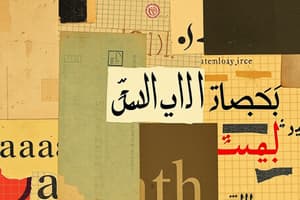Podcast
Questions and Answers
What is the total number of letters in the Arabic alphabet?
What is the total number of letters in the Arabic alphabet?
- 32
- 26
- 28 (correct)
- 30
What is the purpose of diacritics in the Arabic script?
What is the purpose of diacritics in the Arabic script?
- To indicate punctuation
- To indicate consonants
- To indicate capital letters
- To indicate vowels (correct)
Which of the following languages does not have additional letters added or removed from the Arabic script?
Which of the following languages does not have additional letters added or removed from the Arabic script?
- Arwi (correct)
- Malay
- Persian
- Urdu
What is the difference between abjad and hija collating sequences?
What is the difference between abjad and hija collating sequences?
What is the purpose of ḥarakāt in Arabic script?
What is the purpose of ḥarakāt in Arabic script?
How are long vowels represented in unvocalized Arabic text?
How are long vowels represented in unvocalized Arabic text?
What is the sukūn used for in Arabic script?
What is the sukūn used for in Arabic script?
What is the origin of the Arabic alphabet?
What is the origin of the Arabic alphabet?
What is the name of the first software program that identifies Arabic handwriting in real-time?
What is the name of the first software program that identifies Arabic handwriting in real-time?
Flashcards
Full Vocalization
Full Vocalization
The Arabic alphabet is traditionally written with all vowel sounds represented by diacritics above or below consonants.
ḥarakāt
ḥarakāt
Diacritics, also known as ḥarakāt, are marks placed above or below consonants to indicate short vowel sounds in Arabic.
Cursive Script
Cursive Script
The Arabic script is cursive, meaning letters are connected within a word, and most letters have different forms depending on their position within a word.
Consonant Alphabet
Consonant Alphabet
Signup and view all the flashcards
Abjad Numerals
Abjad Numerals
Signup and view all the flashcards
Long 'ā' sound
Long 'ā' sound
Signup and view all the flashcards
Diphthongs
Diphthongs
Signup and view all the flashcards
Short Vowel Marks
Short Vowel Marks
Signup and view all the flashcards
Right-to-Left Writing
Right-to-Left Writing
Signup and view all the flashcards
Study Notes
Arabic is written right to left, in a cursive style and includes 28 letters, with most letters having contextual letterforms. The Arabic alphabet only uses consonants, but means of indicating vowel sounds were later devised by scribes through separate vowel diacritics. Adaptations of the Arabic script for other languages added and removed some letters, as for example Persian, Ottoman Turkish, Kurdish, Urdu, Sindhi, Azerbaijani (in Iran), Malay, Pashto, Punjabi, Uyghur, Arwi and Arabi Malayalam, all of which have additional letters. Both printed and written Arabic are cursive, with most of the letters within a word directly connected to the adjacent letters. There are two main collating sequences for the Arabic alphabet: abjad and hija. Letters can exhibit up to four distinct forms corresponding to an initial, medial (middle), final, or isolated position (IMFI). Short vowels may be written with diacritics placed above or below the consonant that precedes them in the syllable, called ḥarakāt. In the fully vocalized Arabic text found in texts such as Quran, a long ā following a consonant other than a hamzah is written with a short a sign (fatḥah) on the consonant plus an ʾalif after it. In unvocalized text (one in which the short vowels are not marked), the long vowels are represented by the vowel in question: ʾalif ṭawīlah/maqṣūrah, wāw, or yāʾ. The diphthongs /aj/ and /aw/ are represented in vocalized text as follows:. Arabic syllables can be open (ending with a vowel) or closed (ending with a consonant).Overview of the Arabic Alphabet
- The Arabic alphabet is traditionally written in full vocalization.
- The long i sound in some editions of the Qur’an is written with a kasrah followed by a diacritic-less y, and long u by a ḍammah followed by a bare w.
- Outside of the Qur’an, the latter convention is extremely rare, to the point that y with sukūn will be unambiguously read as the diphthong /aj/, and w with sukūn will be read /aw/.
- Vowel marks are always written as if the i‘rāb vowels were in fact pronounced, even when they must be skipped in actual pronunciation.
- Another example: the sentence that in correct literary Arabic must be pronounced Aḥmadu zawjun shirrīr "Ahmad is a wicked husband", is usually mispronounced (due to influence from vernacular Arabic varieties) as Aḥmad zawj shirrīr.
- The sukūn is also used for transliterating words into the Arabic script.
- Some letters take a traditionally different form in specific regions.
- Some modified letters are used to represent non-native sounds of Modern Standard Arabic.
- The Arabic alphabet can be used to represent numbers (Abjad numerals).
- The Arabic alphabet can be traced back to the Nabataean alphabet used to write Nabataean.
- The first known text in the Arabic alphabet is a late 4th-century inscription from Jabal Ramm (50 km east of ‘Aqabah) in Jordan.
- The Arabic alphabet can be encoded using several character sets, including ISO-8859-6, Windows-1256, and Unicode.
- The first software program of its kind in the world that identifies Arabic handwriting in real-time was developed by researchers at Ben-Gurion University (BGU).
Studying That Suits You
Use AI to generate personalized quizzes and flashcards to suit your learning preferences.





